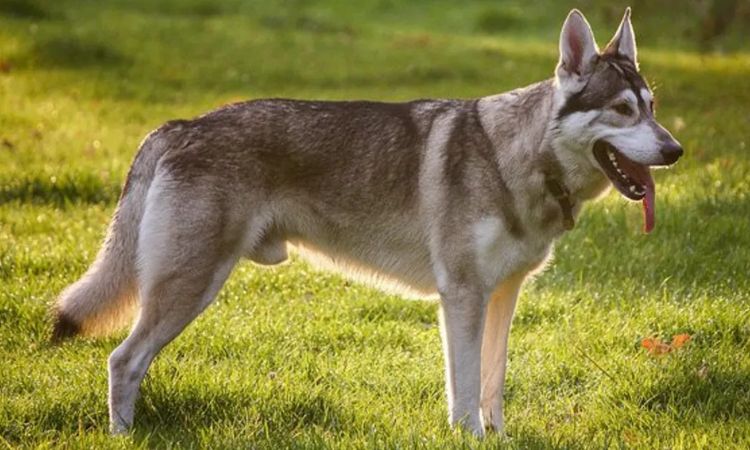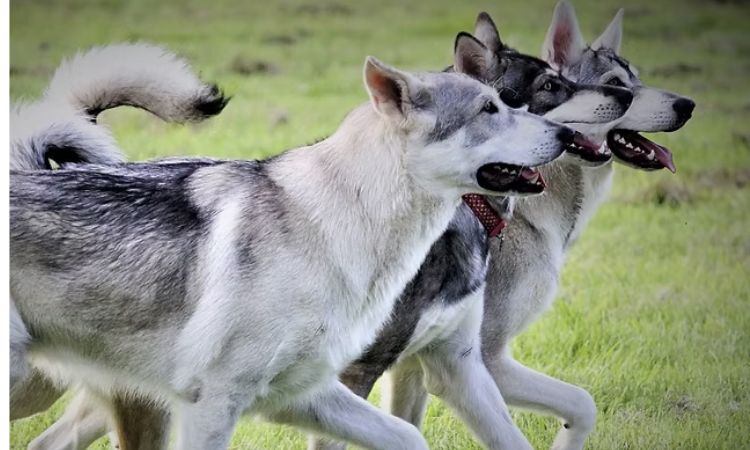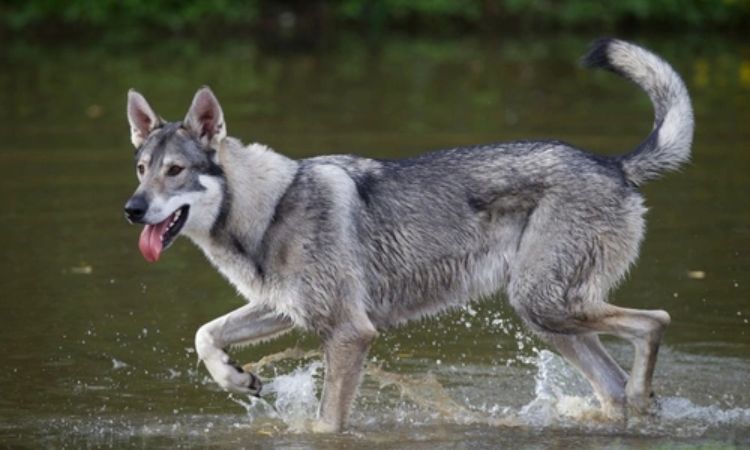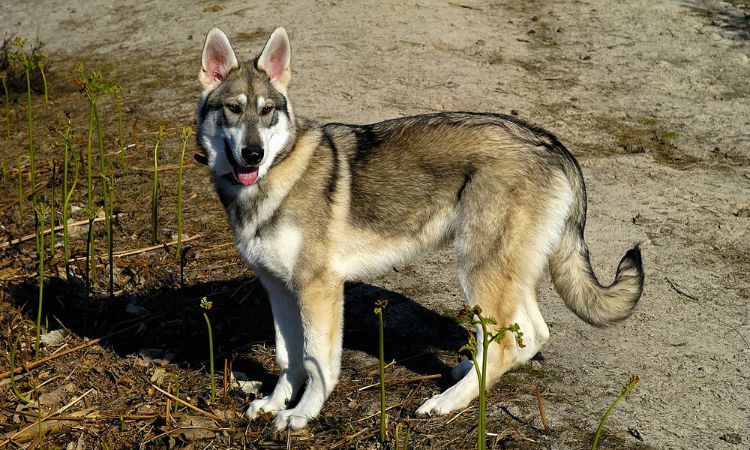The Northern Inuit Dog combines the untamed beauty of a wolf with the gentle, affectionate nature of a loyal family pet. Intelligent and deeply devoted, these dogs quickly form strong bonds with their humans and thrive in loving, active homes.
In this guide, Nexus-Pets explores everything you need to know from their lifespan and care needs to tips on finding Northern Inuit puppies for sale from trusted breeders.

Lifespan of Northern Inuit Dogs
The Northern Inuit Dog typically lives between 12 to 15 years, which is a respectable lifespan for a medium-to-large breed. With proper care, a healthy Northern Inuit can enjoy a long, active life as a devoted companion.
Several factors influence their lifespan, including:
- Genetic health: While generally hardy, they can be prone to conditions such as hip dysplasia or allergies, particularly if not bred responsibly.
- Diet and nutrition: A balanced, high-quality diet tailored to their life stage (puppy, adult, senior) plays a crucial role in overall health and longevity.
- Exercise and mental stimulation: Regular physical activity—like walks, hikes, or canine sports—helps prevent obesity and keeps their minds engaged.
- Routine veterinary care: Preventive care, dental hygiene, vaccinations, and early detection of health issues are essential to a longer, healthier life.
- Living environment: A stable, loving home where they’re not left alone for extended periods can greatly reduce stress-related behaviors and anxiety.
When compared to similar large breeds such as the Alaskan Malamute (10–14 years), German Shepherd (9–13 years), or Siberian Husky (12–14 years)—the Northern Inuit’s lifespan is on the higher end, especially when well cared for. Their longevity, combined with their loyal and gentle temperament, makes them a rewarding choice for experienced dog owners seeking a long-term companion.

Health Concerns and Common Issues
Northern Inuit Dogs, like many large breeds, can be prone to several hereditary health conditions that potential owners and breeders should be aware of to ensure the wellbeing of their dogs.
Hip Dysplasia
Hip dysplasia is a common genetic condition affecting the hip joints, where the joint does not develop properly, leading to arthritis and mobility issues. It can also be influenced by environmental factors such as poor nutrition or over-exercise during puppyhood. Symptoms include difficulty walking, stiffness, and reluctance to move. Prevention mainly involves responsible breeding practices, including hip scoring of breeding dogs to minimize passing the condition to offspring, as well as managing exercise and diet properly during growth.
Elbow Dysplasia
Similar to hip dysplasia, elbow dysplasia involves abnormal development of the elbow joint. It can cause pain, lameness, and arthritis. Like hip dysplasia, all breeding dogs should be elbow scored to reduce incidence in the breed.
Degenerative Myelopathy (DM)
DM is a progressive neurological disease causing weakness and eventual paralysis of the hind limbs. It is hereditary but can be managed through genetic testing. Breeding dogs not clear by parentage should be tested to avoid propagating the disease. The Northern Inuit community actively works to reduce DM in the breed.
Eye Problems Including Glaucoma and Other Disorders
Although not breed-specific, eye conditions like primary and secondary glaucoma can occur and lead to vision loss if untreated. Eye testing for breeding dogs is essential to detect and prevent hereditary eye diseases.
Cryptorchidism (Retained Testicles)
Male Northern Inuits sometimes suffer from retained testicles, where one or both testes fail to descend properly. This condition is typically hereditary and can be managed by neutering at the appropriate age (usually between 18 and 24 months) without lasting health effects.
Other Possible Health Concerns
- Epilepsy: Though its inheritance pattern is unclear, epileptic dogs are excluded from breeding. Epilepsy appears in multiple dog breeds, including Northern Inuits.
- Addison’s Disease: An autoimmune disorder affecting hormone production with possible genetic links. Responsible breeding strategies are used to reduce susceptibility.
- OculoSkeletal Dysplasia Type 3 (OSD3): A breed-specific genetic disorder causing limb deformities and severe eye problems. Testing is required to prevent breeding affected dogs.
Importance of Health Testing Before Breeding and Buying
Health testing is crucial to maintaining the breed’s overall health and longevity. Responsible breeders perform comprehensive screenings—such as hip and elbow scoring, genetic tests for DM and OSD3, eye exams, and monitoring of other inherited diseases—to ensure puppies come from healthy stock.
Prospective owners should seek out breeders who openly share health test results and lineage information, as this transparency is key to minimizing health risks and ensuring a happy, healthy Northern Inuit companion.

Care and Maintenance of Northern Inuit Dogs
Northern Inuit Dogs require dedicated care to maintain their health and happiness, reflecting their active nature and unique physical traits.
Exercise Needs
As a medium-energy breed, Northern Inuit Dogs benefit from daily physical activity to keep both their minds and bodies fit. Regular long walks or jogs, ideally totaling around 45 minutes to an hour each day, help expend their energy and reduce boredom-related behaviors.
They also enjoy interactive play and mentally stimulating games that engage their intelligence. While they appreciate having a secure, fenced yard for occasional off-leash activity, consistent exercise routines are key to preventing restlessness and promoting good behavior.
Diet Considerations
Due to their German Shepherd ancestry, many Northern Inuit Dogs can be prone to sensitive stomachs. Owners often find that a carefully managed diet is essential for digestive health. Raw food diets have become popular among Northern Inuit owners, as many dogs thrive on the natural ingredients and higher protein content these diets provide.
Alternatively, high-quality, grain-free kibble or balanced homemade meals can work well but may require some trial and error to find what suits each individual dog best. Monitoring the dog’s reaction to diet changes and consulting with a veterinarian ensures nutritional needs are met while minimizing gastrointestinal upset.
Grooming Needs
Northern Inuit Dogs possess a dense double coat, with a soft undercoat and a coarser outer layer that protects them from the elements. Despite their longer coats, they are considered moderately low-maintenance in grooming. Brushing two to three times a week with tools like a slicker brush and a deshedder effectively removes loose hair and prevents matting, especially during seasonal shedding periods.
Bathing is rarely necessary unless the dog becomes particularly dirty or smells unpleasant, as they are generally good at self-cleaning. Regular nail trims are important to prevent cracking or overgrowth, and teeth should be brushed weekly to maintain dental health.
Health Monitoring and Routine Care
Routine veterinary care is essential for Northern Inuit Dogs to prevent and detect health issues early. Regular check-ups, up-to-date vaccinations, and scheduled deworming help keep the dog healthy. Preventive measures for parasites, including flea and tick control, should be part of their ongoing care regimen, especially for dogs spending time outdoors.
Given some Northern Inuits’ predisposition to health concerns like hip and elbow dysplasia, epilepsy, and Addison’s disease, owners should maintain open communication with their vet and follow recommended health screenings.

Finding Northern Inuit Puppies for Sale
When searching for a Northern Inuit puppy, it’s essential to focus on reputable sources to ensure you bring home a healthy and well-bred companion. The best place to start is with official breed organizations such as the Northern Inuit Society, which acts as the governing body and provides listings of trusted breeders who adhere to strict health and ethical breeding standards.
Where to Look
Reputable breeders associated with official societies like the Northern Inuit Society are your safest option. These breeders typically follow rigorous protocols including mandatory health screenings and careful lineage documentation. Avoid purchasing from unknown or unverified sellers, as this increases the risk of hereditary health problems and poor temperament.
Questions to Ask Breeders
Before committing, ask potential breeders detailed questions about their breeding program. Important topics include:
- What health tests have the puppy’s parents undergone (e.g., hip and elbow scoring, eye exams, DM and OSD3 genetic testing)?
- Can the breeder provide documented proof of health clearances?
- What is the lineage and background of the puppy? Are there records tracing their ancestry to avoid inbreeding?
- How are the puppies socialized, and what environment are they raised in?
- Are there any known health issues in the puppy’s bloodline?
Responsible breeders will be transparent and willing to provide all relevant information, demonstrating their commitment to maintaining the breed’s health and temperament.
Adoption Considerations and Costs
Northern Inuit puppies typically range from $800 to $1,000, reflecting the breeder’s investment in health testing, proper care, and early socialization. While the initial cost may seem high, it is a worthwhile investment in ensuring a long, healthy, and happy life for your new companion. Occasionally, adoption opportunities arise through breed-specific rescues or rehoming networks, which may be less expensive but still require careful vetting.
Importance of Choosing Responsible Breeders
Selecting a responsible breeder is crucial to minimize the risk of inherited health problems such as hip dysplasia, epilepsy, or Addison’s disease, which can be prevalent in this breed. Good breeders prioritize health testing, ethical breeding practices, and the overall well-being of their dogs. By choosing wisely, you help support the breed’s future and enjoy the full rewards of owning a healthy, well-adjusted Northern Inuit dog.






